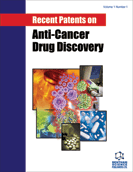
Abstract
Cytosolic NADPH-dependent reductase AKR1B10 is a member of the aldo-keto reductase (AKR) superfamily. This enzyme is normally expressed in the gastrointestinal tract. However, it is overexpressed in many solid tumors, such as hepatocarcinoma, lung cancer and breast cancer. AKR1B10 may play a role in the formation and development of carcinomas through multiple mechanisms including detoxification of cytotoxic carbonyls, modulation of retinoic acid level, and regulation of cellular fatty acid synthesis and lipid metabolism. Studies have suggested that AKR1B10 may be a useful biomarker for cancer diagnosis and a potential target for cancer treatment. Over the last decade, a number of AKR1B10 inhibitors including aldose reductase inhibitors (ARIs), endogenous substances, natural-based derivatives and synthetic compounds have been developed, which could be novel anticancer drugs. This review provides an overview on related articles and patents about AKR1B10 inhibitors, with a focus on their inhibition selectivity and mechanism of function.
Keywords: AKR1B10, Aldo-keto reductase, ARL-1, cancer, chemoresistance, inhibitors.
Recent Patents on Anti-Cancer Drug Discovery
Title:Aldo-Keto Reductase Family 1 Member B10 Inhibitors: Potential Drugs for Cancer Treatment
Volume: 11 Issue: 2
Author(s): Li Huang, Rongzhang He, Weihao Luo, Yuan-Shan Zhu, Jia Li, Tan Tan, Xi Zhang, Zheng Hu and Dixian Luo
Affiliation:
Keywords: AKR1B10, Aldo-keto reductase, ARL-1, cancer, chemoresistance, inhibitors.
Abstract: Cytosolic NADPH-dependent reductase AKR1B10 is a member of the aldo-keto reductase (AKR) superfamily. This enzyme is normally expressed in the gastrointestinal tract. However, it is overexpressed in many solid tumors, such as hepatocarcinoma, lung cancer and breast cancer. AKR1B10 may play a role in the formation and development of carcinomas through multiple mechanisms including detoxification of cytotoxic carbonyls, modulation of retinoic acid level, and regulation of cellular fatty acid synthesis and lipid metabolism. Studies have suggested that AKR1B10 may be a useful biomarker for cancer diagnosis and a potential target for cancer treatment. Over the last decade, a number of AKR1B10 inhibitors including aldose reductase inhibitors (ARIs), endogenous substances, natural-based derivatives and synthetic compounds have been developed, which could be novel anticancer drugs. This review provides an overview on related articles and patents about AKR1B10 inhibitors, with a focus on their inhibition selectivity and mechanism of function.
Export Options
About this article
Cite this article as:
Huang Li, He Rongzhang, Luo Weihao, Zhu Yuan-Shan, Li Jia, Tan Tan, Zhang Xi, Hu Zheng and Luo Dixian, Aldo-Keto Reductase Family 1 Member B10 Inhibitors: Potential Drugs for Cancer Treatment, Recent Patents on Anti-Cancer Drug Discovery 2016; 11 (2) . https://dx.doi.org/10.2174/1574892811888160304113346
| DOI https://dx.doi.org/10.2174/1574892811888160304113346 |
Print ISSN 1574-8928 |
| Publisher Name Bentham Science Publisher |
Online ISSN 2212-3970 |
 150
150 17
17 1
1 1
1
- Author Guidelines
- Graphical Abstracts
- Fabricating and Stating False Information
- Research Misconduct
- Post Publication Discussions and Corrections
- Publishing Ethics and Rectitude
- Increase Visibility of Your Article
- Archiving Policies
- Peer Review Workflow
- Order Your Article Before Print
- Promote Your Article
- Manuscript Transfer Facility
- Editorial Policies
- Allegations from Whistleblowers
Related Articles
-
Pharmacogenomics in Colorectal Cancer
Current Pharmacogenomics Anti-Inflammatory Treatments for Chronic Diseases: A Review
Inflammation & Allergy - Drug Targets (Discontinued) Estrogen Receptors: Molecular Interactions, Virtual Screening and Future Prospects
Current Topics in Medicinal Chemistry Steroid Biosynthesis Inhibitors in the Therapy of Hypercortisolism: Theory and Practice
Current Medicinal Chemistry Characterization of Liver- and Cancer-type-Organic Anion Transporting Polypeptide (OATP) 1B3 Messenger RNA Expression in Normal and Cancerous Human Tissues
Drug Metabolism Letters Electrochemical Nanomaterial-based Sensors/Biosensors for Drug Monitoring
Current Topics in Medicinal Chemistry A Novel Assay Platform for the Detection of Translation Modulators of Spermidine/ Spermine Acetyltransferase
Current Pharmaceutical Design Patent Selections
Current Biomarkers (Discontinued) Naringenin and Ellagic Acid Reduce Tetrazolium Salt in the Absence of Cells
The Natural Products Journal The Roles of Sox Family Genes in Sarcoma
Current Drug Targets Review of Dose-intense Platinum and/or Paclitaxel Containing Chemotherapy in Advanced and Recurrent Epithelial Ovarian Cancer
Current Pharmaceutical Design Molecular Surgery with Auger Electron-Emitting Radiopharmaceuticals
Current Radiopharmaceuticals Interaction of ABC Multidrug Transporters with Anticancer Protein Kinase Inhibitors: Substrates and/or Inhibitors?
Current Cancer Drug Targets Impact of Viscosity and Refractive Index on Droplet Size and Zeta Potential of Model O/W and W/O Nanoemulsion
Current Nanoscience The Effects of Insulin and Insulin-Like Growth Factors on Tumor Vascularization: New Insights of Insulin-Like Growth Factor Family in Cancer
Current Medicinal Chemistry Celastrus Orbiculatus Extract Potentiates the Sensitivity of Cisplatin Via Caspase-Depenent Apoptosis in Gastric Cancer
Anti-Cancer Agents in Medicinal Chemistry Pharmacologic Evidence of Green Tea in Targeting Tyrosine Kinases
Current Reviews in Clinical and Experimental Pharmacology Effects of Thermal Treatments on Donkey Milk Nutritional Characteristics
Recent Patents on Food, Nutrition & Agriculture Advanced Drug Delivery of N-Acetylcarnosine (N-Acetyl-beta-alanyl-Lhistidine), Carcinine (Beta-alanylhistamine) and L-carnosine (Beta-alanyl- L-histidine) in Targeting Peptide Compounds as Pharmacological Chaperones for Use in Tissue Engineering, Human Disease Management and Therapy: From in vitro to the Clinic
Recent Patents on Drug Delivery & Formulation 1, 3, 6-Trihydroxy-7-Methyl-9, 10-Anthracenedione Isolated from genus Lindera with Anti-Cancer Activity
Anti-Cancer Agents in Medicinal Chemistry


























